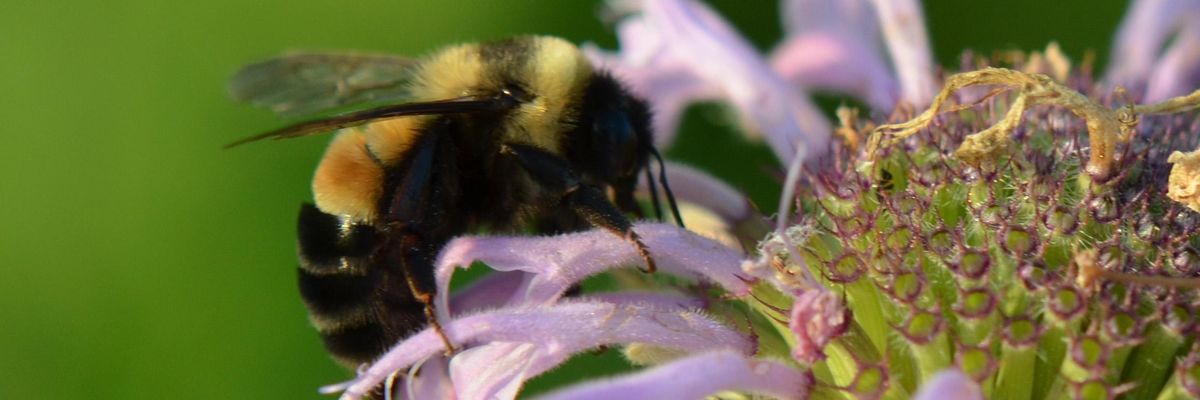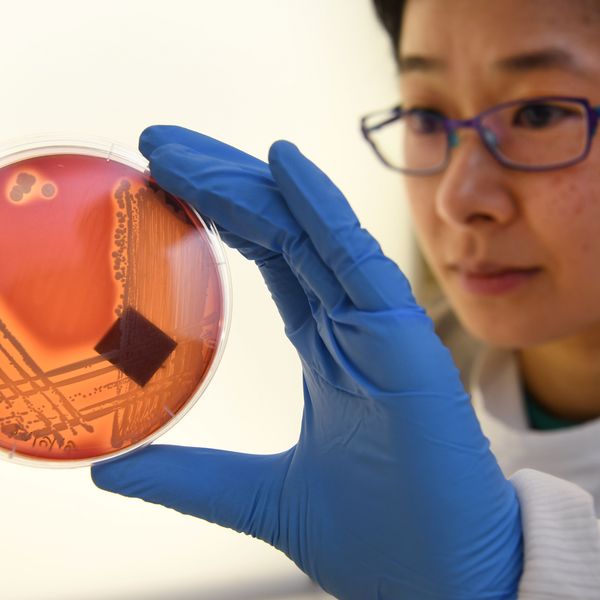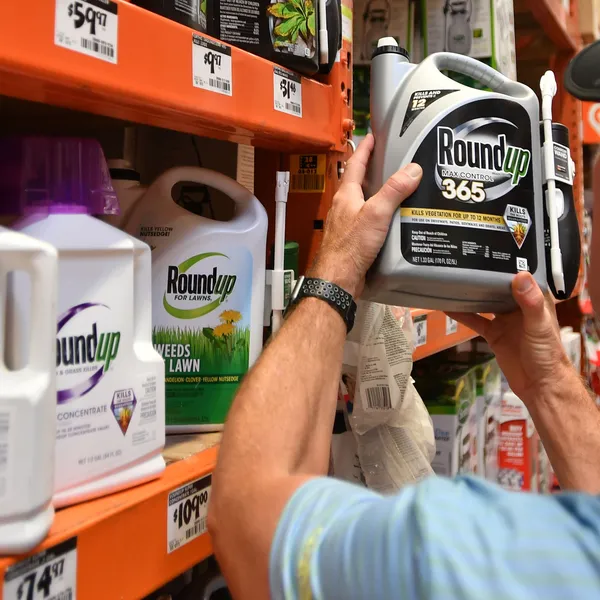
The U.S. Environmental Protection Agency concluded that three neonics are "likely to adversely affect" most endangered and threatened species, including the rusty patched bumblebee. (Photo: USFWS)
Groups Tell EPA 'Damning Admissions' on Neonics Should Result in Full Ban
"These deeply troubling findings leave no doubt that these dangerous pesticides are silencing the songs of frogs, the flutter of butterfly wings, and the buzz of bees."
Advocacy groups on Thursday responded to the Biden administration's new conclusions about how a trio of popular neonicotinoid pesticides threaten endangered species with calls for a total ban on the products.
"Now that the EPA has completed its analysis, the only question is whether it will muster the courage to stand up to Big Ag and ban these chemicals."
The federal review focused on clothianidin, imidacloprid, and thiamethoxam, which "are used on a variety of crops, turf, and ornamentals, and for other residential and commercial indoor and outdoor uses," the U.S. Environmental Protection Agency (EPA) explained.
The agency determined all three are "likely to adversely affect" the majority of federally listed endangered or threatened species and their designated critical habitats--which "means that EPA reasonably expects that at least one individual animal or plant, among a variety of listed species, may be exposed to the pesticide at a sufficient level to have an adverse effect."
Specifically, clothianidin is likely to adversely affect 67% of species and 56% of habitats; for, imidacloprid, those figures are 79% and 83%; and for thiamethoxam, they are 77% and 81%.
Impacted species include the California red-legged frog, chinook salmon, Florida panther, karner blue butterfly, northern long-eared bat, orca, rusty patched bumblebee, whooping crane, and yellow larkspur.
"Because of these findings, EPA has initiated formal consultation with the U.S. Fish and Wildlife Service and the National Marine Fisheries Service," and will be working with each to determine how the information "can best inform the services' biological opinions," the agency said.
While neonics are widely known for harming bees and other pollinators--and are banned in the European Union--this is the first time the EPA has reviewed impacts of this class of pesticides on the nation's most imperiled species.
The agency was required to conduct and release biological evaluations (BEs) due to a 2019 legal settlement resulting from litigation initiated by the Center for Food Safety (CFS). The final releases Thursday followed drafts published for public comment last year.
"These evaluations, which encompass all registered uses and approved product labels for pesticide products containing these chemicals, are part of EPA's efforts to meet its obligations under the Endangered Species Act (ESA)," the agency acknowledged.
The work, the agency added, also "furthers the goals" outlined in its first-ever plan to protect endangered species from pesticides--a blueprint the Biden administration unveiled in April that was met with cautious optimism from environmental campaigners.
Related Content

Biden EPA Unveils 'First-Ever' Blueprint to Protect Endangered Species From Pesticides
Responding to the BEs in a statement Thursday, CFS legal director George Kimbrell said that "EPA admitted what we have long warned: Neonics are causing grave harm to not just bees but to the vast majority of all endangered species."
"These damning admissions should result in neonics being banned, as they are in Europe," he asserted. "Formal consultation with the expert wildlife agencies must now be completed and significant safeguards put in place to protect the environment--if this class of pesticide can be used safely at all. We will continue to watchdog the agency to ensure it complies with its legal duties."
"The wildlife agencies now must now make the right calls to protect already endangered life from these biocides."
CFS science director Bill Freese echoed the call for swift federal action.
"Neonicotinoids are known for their toxicity to bees and other insects, but today EPA's assessment demonstrates harms across the spectrum of already imperiled animal and plant life," he said. "The wildlife agencies now must now make the right calls to protect already endangered life from these biocides."
Lori Ann Burd, environmental health director at the Center for Biological Diversity, also pointed to the BEs as proof that the federal government needs to outlaw neonics.
"These deeply troubling findings leave no doubt that these dangerous pesticides are silencing the songs of frogs, the flutter of butterfly wings, and the buzz of bees," said Burd. "Many of the species harmed by neonicotinoids are experiencing precipitous declines, and this EPA's choices may well determine whether or not they go extinct."
"We're in the midst of a heartbreaking extinction crisis and neonicotinoids are playing an outsized role in driving it," she noted. "Now that the EPA has completed its analysis, the only question is whether it will muster the courage to stand up to Big Ag and ban these chemicals or will choose to facilitate extinction."
The EPA evaluations and reactions came the same day that a coalition led by the Center for Biological Diversity and the Natural Resources Defense Council urged policymakers attending a global summit next week to "make 2022 the year in which the world chooses to stop extinction and commits the resources to do so."
An Urgent Message From Our Co-Founder
Dear Common Dreams reader, The U.S. is on a fast track to authoritarianism like nothing I've ever seen. Meanwhile, corporate news outlets are utterly capitulating to Trump, twisting their coverage to avoid drawing his ire while lining up to stuff cash in his pockets. That's why I believe that Common Dreams is doing the best and most consequential reporting that we've ever done. Our small but mighty team is a progressive reporting powerhouse, covering the news every day that the corporate media never will. Our mission has always been simple: To inform. To inspire. And to ignite change for the common good. Now here's the key piece that I want all our readers to understand: None of this would be possible without your financial support. That's not just some fundraising cliche. It's the absolute and literal truth. We don't accept corporate advertising and never will. We don't have a paywall because we don't think people should be blocked from critical news based on their ability to pay. Everything we do is funded by the donations of readers like you. Will you donate now to help power the nonprofit, independent reporting of Common Dreams? Thank you for being a vital member of our community. Together, we can keep independent journalism alive when it’s needed most. - Craig Brown, Co-founder |
Advocacy groups on Thursday responded to the Biden administration's new conclusions about how a trio of popular neonicotinoid pesticides threaten endangered species with calls for a total ban on the products.
"Now that the EPA has completed its analysis, the only question is whether it will muster the courage to stand up to Big Ag and ban these chemicals."
The federal review focused on clothianidin, imidacloprid, and thiamethoxam, which "are used on a variety of crops, turf, and ornamentals, and for other residential and commercial indoor and outdoor uses," the U.S. Environmental Protection Agency (EPA) explained.
The agency determined all three are "likely to adversely affect" the majority of federally listed endangered or threatened species and their designated critical habitats--which "means that EPA reasonably expects that at least one individual animal or plant, among a variety of listed species, may be exposed to the pesticide at a sufficient level to have an adverse effect."
Specifically, clothianidin is likely to adversely affect 67% of species and 56% of habitats; for, imidacloprid, those figures are 79% and 83%; and for thiamethoxam, they are 77% and 81%.
Impacted species include the California red-legged frog, chinook salmon, Florida panther, karner blue butterfly, northern long-eared bat, orca, rusty patched bumblebee, whooping crane, and yellow larkspur.
"Because of these findings, EPA has initiated formal consultation with the U.S. Fish and Wildlife Service and the National Marine Fisheries Service," and will be working with each to determine how the information "can best inform the services' biological opinions," the agency said.
While neonics are widely known for harming bees and other pollinators--and are banned in the European Union--this is the first time the EPA has reviewed impacts of this class of pesticides on the nation's most imperiled species.
The agency was required to conduct and release biological evaluations (BEs) due to a 2019 legal settlement resulting from litigation initiated by the Center for Food Safety (CFS). The final releases Thursday followed drafts published for public comment last year.
"These evaluations, which encompass all registered uses and approved product labels for pesticide products containing these chemicals, are part of EPA's efforts to meet its obligations under the Endangered Species Act (ESA)," the agency acknowledged.
The work, the agency added, also "furthers the goals" outlined in its first-ever plan to protect endangered species from pesticides--a blueprint the Biden administration unveiled in April that was met with cautious optimism from environmental campaigners.
Related Content

Biden EPA Unveils 'First-Ever' Blueprint to Protect Endangered Species From Pesticides
Responding to the BEs in a statement Thursday, CFS legal director George Kimbrell said that "EPA admitted what we have long warned: Neonics are causing grave harm to not just bees but to the vast majority of all endangered species."
"These damning admissions should result in neonics being banned, as they are in Europe," he asserted. "Formal consultation with the expert wildlife agencies must now be completed and significant safeguards put in place to protect the environment--if this class of pesticide can be used safely at all. We will continue to watchdog the agency to ensure it complies with its legal duties."
"The wildlife agencies now must now make the right calls to protect already endangered life from these biocides."
CFS science director Bill Freese echoed the call for swift federal action.
"Neonicotinoids are known for their toxicity to bees and other insects, but today EPA's assessment demonstrates harms across the spectrum of already imperiled animal and plant life," he said. "The wildlife agencies now must now make the right calls to protect already endangered life from these biocides."
Lori Ann Burd, environmental health director at the Center for Biological Diversity, also pointed to the BEs as proof that the federal government needs to outlaw neonics.
"These deeply troubling findings leave no doubt that these dangerous pesticides are silencing the songs of frogs, the flutter of butterfly wings, and the buzz of bees," said Burd. "Many of the species harmed by neonicotinoids are experiencing precipitous declines, and this EPA's choices may well determine whether or not they go extinct."
"We're in the midst of a heartbreaking extinction crisis and neonicotinoids are playing an outsized role in driving it," she noted. "Now that the EPA has completed its analysis, the only question is whether it will muster the courage to stand up to Big Ag and ban these chemicals or will choose to facilitate extinction."
The EPA evaluations and reactions came the same day that a coalition led by the Center for Biological Diversity and the Natural Resources Defense Council urged policymakers attending a global summit next week to "make 2022 the year in which the world chooses to stop extinction and commits the resources to do so."
Advocacy groups on Thursday responded to the Biden administration's new conclusions about how a trio of popular neonicotinoid pesticides threaten endangered species with calls for a total ban on the products.
"Now that the EPA has completed its analysis, the only question is whether it will muster the courage to stand up to Big Ag and ban these chemicals."
The federal review focused on clothianidin, imidacloprid, and thiamethoxam, which "are used on a variety of crops, turf, and ornamentals, and for other residential and commercial indoor and outdoor uses," the U.S. Environmental Protection Agency (EPA) explained.
The agency determined all three are "likely to adversely affect" the majority of federally listed endangered or threatened species and their designated critical habitats--which "means that EPA reasonably expects that at least one individual animal or plant, among a variety of listed species, may be exposed to the pesticide at a sufficient level to have an adverse effect."
Specifically, clothianidin is likely to adversely affect 67% of species and 56% of habitats; for, imidacloprid, those figures are 79% and 83%; and for thiamethoxam, they are 77% and 81%.
Impacted species include the California red-legged frog, chinook salmon, Florida panther, karner blue butterfly, northern long-eared bat, orca, rusty patched bumblebee, whooping crane, and yellow larkspur.
"Because of these findings, EPA has initiated formal consultation with the U.S. Fish and Wildlife Service and the National Marine Fisheries Service," and will be working with each to determine how the information "can best inform the services' biological opinions," the agency said.
While neonics are widely known for harming bees and other pollinators--and are banned in the European Union--this is the first time the EPA has reviewed impacts of this class of pesticides on the nation's most imperiled species.
The agency was required to conduct and release biological evaluations (BEs) due to a 2019 legal settlement resulting from litigation initiated by the Center for Food Safety (CFS). The final releases Thursday followed drafts published for public comment last year.
"These evaluations, which encompass all registered uses and approved product labels for pesticide products containing these chemicals, are part of EPA's efforts to meet its obligations under the Endangered Species Act (ESA)," the agency acknowledged.
The work, the agency added, also "furthers the goals" outlined in its first-ever plan to protect endangered species from pesticides--a blueprint the Biden administration unveiled in April that was met with cautious optimism from environmental campaigners.
Related Content

Biden EPA Unveils 'First-Ever' Blueprint to Protect Endangered Species From Pesticides
Responding to the BEs in a statement Thursday, CFS legal director George Kimbrell said that "EPA admitted what we have long warned: Neonics are causing grave harm to not just bees but to the vast majority of all endangered species."
"These damning admissions should result in neonics being banned, as they are in Europe," he asserted. "Formal consultation with the expert wildlife agencies must now be completed and significant safeguards put in place to protect the environment--if this class of pesticide can be used safely at all. We will continue to watchdog the agency to ensure it complies with its legal duties."
"The wildlife agencies now must now make the right calls to protect already endangered life from these biocides."
CFS science director Bill Freese echoed the call for swift federal action.
"Neonicotinoids are known for their toxicity to bees and other insects, but today EPA's assessment demonstrates harms across the spectrum of already imperiled animal and plant life," he said. "The wildlife agencies now must now make the right calls to protect already endangered life from these biocides."
Lori Ann Burd, environmental health director at the Center for Biological Diversity, also pointed to the BEs as proof that the federal government needs to outlaw neonics.
"These deeply troubling findings leave no doubt that these dangerous pesticides are silencing the songs of frogs, the flutter of butterfly wings, and the buzz of bees," said Burd. "Many of the species harmed by neonicotinoids are experiencing precipitous declines, and this EPA's choices may well determine whether or not they go extinct."
"We're in the midst of a heartbreaking extinction crisis and neonicotinoids are playing an outsized role in driving it," she noted. "Now that the EPA has completed its analysis, the only question is whether it will muster the courage to stand up to Big Ag and ban these chemicals or will choose to facilitate extinction."
The EPA evaluations and reactions came the same day that a coalition led by the Center for Biological Diversity and the Natural Resources Defense Council urged policymakers attending a global summit next week to "make 2022 the year in which the world chooses to stop extinction and commits the resources to do so."

